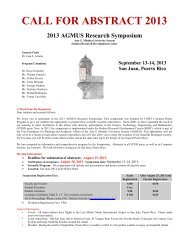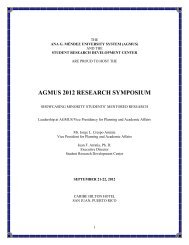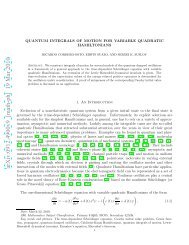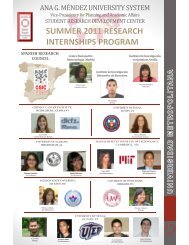WINTER 2008 PRE-COLLEGE RESEARCH SYMPOSIUM - Student ...
WINTER 2008 PRE-COLLEGE RESEARCH SYMPOSIUM - Student ...
WINTER 2008 PRE-COLLEGE RESEARCH SYMPOSIUM - Student ...
You also want an ePaper? Increase the reach of your titles
YUMPU automatically turns print PDFs into web optimized ePapers that Google loves.
PIEBALDIMS DISEASE CAUSED BY MUTATIONS IN KIT GENE<br />
Zashari Brainin, Bautista de Levittown School, Toa Baja, Puerto Rico.<br />
Research Mentors: Dr. Juan F. Arratia, Executive Director, <strong>Student</strong> Research Development<br />
Center, Ana G. Méndez University System, San Juan, Puerto Rico; Dr. Sudhir Kumar,<br />
Department of Biology, Arizona State University, Tempe, Arizona.<br />
<strong>Student</strong> Research Mentor: Cristina Rivera, Universidad Metropolitana, San Juan, Puerto Rico.<br />
Piebaldism is a rare autosomal dominant disorder of melanocyte development characterized by a<br />
congenital white forelock and multiple symmetrical hypopigmented or depigmented macules. The<br />
underlying defect is possibly related to the differentiation and migration of melanoblasts, as well<br />
as to defective development of the neural crest (neurocristopathy). Piebaldism is due to an<br />
absence of melanocytes in affected skin and hair follicles as a result of mutations of the KIT<br />
proto-oncogene, located in chromosome 4 ( Locus 4q11-q12). Using SIFT program, the severity<br />
of changes in amino acids that leads to mutations was predicted. The fact of whether changes are<br />
going to be tolerated or not by humans was studied. Another important part of our research was to<br />
compare the KIT gene in humans with the same gene in other species to study the evolution of it<br />
through time.<br />
EVALUATION OF DIFFERENCES IN THE JAG1 MUTATIONS<br />
Susana Soto, Bautista de Levittown School, Toa Baja, Puerto Rico.<br />
Research Mentors: Dr. Juan F. Arratia, Executive Director, <strong>Student</strong> Research Development<br />
Center, Ana G. Méndez University System, San Juan, Puerto Rico; Dr. Sudhir Kumar,<br />
Department of Biology, Arizona State University, Tempe, Arizona.<br />
<strong>Student</strong> Research Mentor: Krizia Cabrera, Universidad Metropolitana, San Juan, Puerto Rico.<br />
Mutations in Jagged 1(JAG1) gene lead to Alagille syndrome, which is an inherited autosomic<br />
dominant disease defined by the shortage of the hepatic ducts, along with anomaly in multiple<br />
organs and systems. It is diagnosed during childhood because of the detection of cardiac<br />
malformation. This syndrome causes abnormalities of the liver, heart, skeleton, eye, kidneys,<br />
physical appearance, and sometimes even mental retardation. The program SIFT (Sorting<br />
Intolerant From Tolerant) was used to study the severity of changes in amino acids and if these<br />
mutations are tolerable or not to the protein function and structure. A search for other homolog<br />
species was conducted. Using MEGA4 (Molecular Evolutionary Genetics Analysis 4), the<br />
evolutionary change in the JAG1 protein of the following species was compared: Rattus<br />
norvegicus, Mus Musculus, Bos Taurus, Pan Troglodytes, and Ovis Aries. Each substitution was<br />
evaluated for biochemical severity using Grantham distance, the distance between the original<br />
amino acid and the mutated amino acid. MEGA4 was used to do a protein alignment of these<br />
sequences. Of the mutations evaluated by SIFT, 78% were not tolerable. Theses results may<br />
imply that these amino acids are very important for the function of the protein.<br />
22








